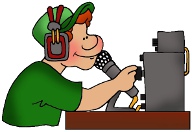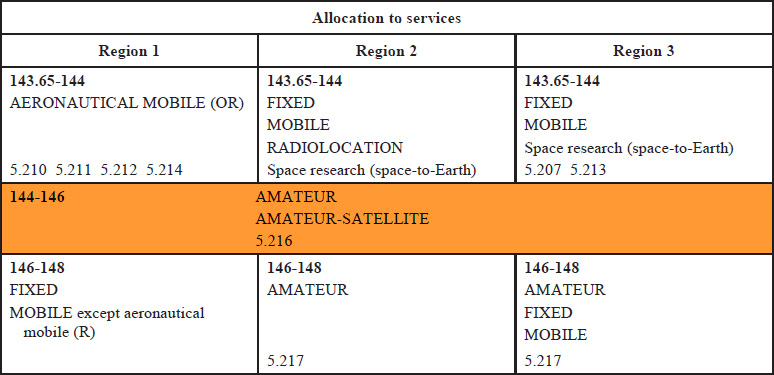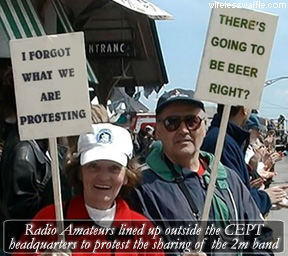Sunday 30 June, 2019, 19:05 - Amateur Radio, Spectrum Management
The use of the radio spectrum in Europe is determined by a range of different organisations. At the truly international level, the ITU dictates which services are allocated which parts of the spectrum in its Radio Regulations which are updated every 3 to 4 years as the result of the World Radiocommunications Conference (WRC) at which every country in the world's regulators sit down and agree on any changes. At the more regional level, CEPT propose and make decisions on the use of spectrum in Europe. In the case of both the ITU and CEPT, several working groups are established to consider different topics such as fixed links, mobile services and satellite services.  A recent meeting of CEPT/ECC Working Group PT-A which took place in June in Prague, Czechia, was considering the items that should go on the agenda of the 2023 WRC, as these need to be agreed at the 2019 WRC to be held later this year. At this meeting, the French spectrum regulator, the ANFR, updated a proposal concerning:
A recent meeting of CEPT/ECC Working Group PT-A which took place in June in Prague, Czechia, was considering the items that should go on the agenda of the 2023 WRC, as these need to be agreed at the 2019 WRC to be held later this year. At this meeting, the French spectrum regulator, the ANFR, updated a proposal concerning:an agenda item for new non-safety aeronautical mobile applications.
Non-safety aeronautical mobile services are likely to consist of things such as the remote control of (military) drones. As a result of this submission, the meeting has proposed an item that will be taken by CEPT member countries to the next WRC which states:
New non-safety aeronautical mobile applications will support applications like: imagery, video, fire and border surveillance, environment monitoring, traffic/disaster monitoring. Such applications require ground to air, air to ground and air to air, communications on-board manned and unmanned aircraft. Use of innovative sharing methods may be considered to ensure the protection of existing services while offering the possibility to have access to new frequency bands. Several frequency bands are proposed for investigation within different ranges in order to meet the various operational requirements for new non-safety aeronautical mobile applications.
It is proposed to study the bands 162.0375-174.000 MHz, 862-874 MHz and 22-22.21 GHz in order to evaluate the possible revision or deletion of the "except aeronautical mobile" restriction and the bands 144-146 MHz, 5000-5010 MHz and 15.4-15.7 GHz for possible new allocations to the aeronautical mobile service.
 Hidden amongst this is a potential time-bomb for radio amateurs. The French administration is effectively proposing that the 2 metre amateur band (144 - 146 MHz) which is currently allocated for the exclusive use by radio amateurs, should be shared with non-safety aeronautical mobile services. Note that this is already the case in China and that in Region 1 (Europe) the spectrum immediately below the 144 MHz band is already allocate for Aeronautical Mobile services. The proposal does not state whether the new allocation should be on a secondary basis (in which case radio amateurs would continue to be protected from interference) or whether it would be on a co-primary basis (in which case both sets of users would have equivalent interference protection rights).
Hidden amongst this is a potential time-bomb for radio amateurs. The French administration is effectively proposing that the 2 metre amateur band (144 - 146 MHz) which is currently allocated for the exclusive use by radio amateurs, should be shared with non-safety aeronautical mobile services. Note that this is already the case in China and that in Region 1 (Europe) the spectrum immediately below the 144 MHz band is already allocate for Aeronautical Mobile services. The proposal does not state whether the new allocation should be on a secondary basis (in which case radio amateurs would continue to be protected from interference) or whether it would be on a co-primary basis (in which case both sets of users would have equivalent interference protection rights).
Wireless Waffle understands that the proposal was originated by French defence manufacturer Thales, and that their preferred outcome would be a co-primary allocation. Should this happen, notwithstanding the fact that there would be an interferer in the 2 metre band, the aeronautical services, if they suffered interference from amateurs, could them potential claim protection. It is not completely impossible that as a result of this, the amateur service could be either reduced to secondary status, or told to leave the band. Such an outcome would take at least 12 years, as it would first have to be put on the agenda for a future WRC (which could not be until at least 2027), then studied, before a decision could be made (at the eariest 2031).
Should radio amateurs be concerned. In a word, YES! The 2 metre band is very heavily used and is one of the only primary and exclusive amateur radio allocations that exists. A number of other amateur bands have recently been reduced or lost to other services (e.g. 2.3 GHz, 3.4 GHz) and there is also consideration of removing the amateur service from the 23cm band from 1260 to 1300 MHz to protect satellite navigation systems. However inconceivable it may be that the 2 metre band could go the same way, it is not impossible.
 What can radio amateurs do? It is the national radio spectrum administrations who attends the CEPT/ECC meetings and represents the views of their country. In the first instance, therefore, amateurs should write to their national regulator (e.g. Ofcom in the UK) and express the importance of keeping the 2 metre band primary and exclusive for amateur use.
What can radio amateurs do? It is the national radio spectrum administrations who attends the CEPT/ECC meetings and represents the views of their country. In the first instance, therefore, amateurs should write to their national regulator (e.g. Ofcom in the UK) and express the importance of keeping the 2 metre band primary and exclusive for amateur use. International organisations such as the IARU and national organisations such as the RSGB get involved to support the interests of radio amateurs, but this can only succeed if the national administrations listen empathetically.
If national administrations fail to support the amateur service, the next step would probably be for radio amateurs to protest outside CEPT/ECC meetings to try and demonstrate to CEPT just how strongly they object.
Deke
Wednesday 10 July, 2019, 10:44
The beginning of the end for the amateurs. HF is full of noise. VHF is going. And anything above VHF has largely already gone. Grab 27 MHz while you can.